Assessment of the Effects of Artificial Fungi Inoculations on Agarwood Formation and Sap Flow Rate of Aquilaria malaccensis Lam. Using Sonic Tomography (SoT) and Sap Flow Meter (SFM)
Abstract
:1. Introduction
2. Materials and Methods
2.1. Study Area
2.2. Tree Selection Method
2.3. Identification of Fungi
2.4. Inoculation Treatments
2.5. Observation of the Effects of Inoculations
2.6. Observation of the Effects of Sap Flow (SF) Rate
2.7. Statistical Analysis
3. Results and Discussion
3.1. Visual Observation
3.2. Non-Destructive Observation
3.2.1. Sapwood Area Condition Effects
3.2.2. Detection of Differentiation by Tomogram Colour Images
3.3. Deteriorated Wood Effected by Diameter Class
3.4. Deteriorated Wood Influenced by Inoculation Position
3.5. Evaluation of Sap Flow Rate
3.5.1. Average Sap Rate Flow Influenced in Inoculated Trees
3.5.2. Diurnal Sap Flow Rate Influenced in Inoculated Trees
3.5.3. The Effect of Temperature on the Sap Flow Rate
4. Conclusions
Author Contributions
Funding
Institutional Review Board Statement
Informed Consent Statement
Data Availability Statement
Conflicts of Interest
References
- Chua, L.S.L.; Lee, S.L.; Lau, K.H.; Zakaria, N.F.; Tnah, L.H.; Lee, C.T.; Ng, C.H.; Ng, K.K.S. Conservation Action Plan: For the Threatened Agarwood Species Aquilaria malaccensis (Thymelaeaceae) in Peninsular Malaysia; Forest Research Institute Malaysia: Kuala Lumpur, Malaysia, 2016; ISBN 9789670622590. [Google Scholar]
- Abd Majid, J.; Hazandy, A.H.; Paridah, M.T.; Nor Azah, M.A.; Mailina, J.; Saidatul Husni, S.; Sahrim, L. Determination of Agarwood Volatile Compounds from Selected Aquilaria Species Plantation Extracted by Headspace-Solid Phase Microextraction (HS-SPME) Method. In IOP Conference Series: Materials Science and Engineering; Institute of Physics Publishing: Bristol, UK, 2018; Volume 368. [Google Scholar]
- Alamil, J.M.R.; Paudel, K.R.; Chan, Y.; Xenaki, D.; Panneerselvam, J.; Singh, S.K.; Gulati, M.; Jha, N.K.; Kumar, D.; Prasher, P.; et al. Rediscovering the Therapeutic Potential of Agarwood in the Management of Chronic Inflammatory Diseases. Molecules 2022, 27, 3038. [Google Scholar] [CrossRef] [PubMed]
- Eissa, M.A.; Hashim, Y.Z.H.Y.; Abdul Azziz, S.S.S.; Salleh, H.M.; Isa, M.L.M.; Abd Warif, N.M.; Abdullah, F.; Ramadan, E.; El-Kersh, D.M. Phytochemical Constituents of Aquilaria malaccensis Leaf Extract and Their Anti-Inflammatory Activity against LPS/IFN-γ-Stimulated RAW 264.7 Cell Line. ACS Omega 2022, 7, 15637–15646. [Google Scholar] [CrossRef] [PubMed]
- Chua, L. Agarwood (Aquilaria malaccensis) in Malaysia. In NDF Workshop Case Studies, WG1—Trees, Case Study 3; Forest Research Institute Malaysia: Kuala Lumpur, Malaysia, 2008; pp. 1–17. [Google Scholar]
- Desa, A.P.; Lee, S.Y.; Mustapa, M.Z.; Mohamed, R.; Emang, D. Trends in the Agarwood Industry of Peninsular Malaysia. Malays. For. 2021, 84, 152–168. [Google Scholar]
- CITES. Consideration of Proposals for Amendment of Appendices I and II—Proposal 4. In Proceedings of the Seventeenth Meeting of the Conference of the Parties, Johannesburg, South Africa, 24 September–5 October 2016; pp. 1–23. [Google Scholar]
- Justin, S.; Lihan, S.; Elvis-Sulang, M.R.; Chiew, T.S. Formulated Microbial Consortium as Inoculant for Agarwood Induction. J. Trop. For. Sci. 2020, 32, 161–169. [Google Scholar] [CrossRef]
- Wang, Y.; Hussain, M.; Jiang, Z.; Wang, Z.; Gao, J.; Ye, F.; Mao, R.; Li, H. Aquilaria Species (Thymelaeaceae) Distribution, Volatile and Non-Volatile Phytochemicals, Pharmacological Uses, Agarwood Grading System, and Induction Methods. Molecules 2021, 26, 7708. [Google Scholar] [CrossRef] [PubMed]
- Azren, P.D.; Lee, S.Y.; Emang, D.; Mohamed, R. History and Perspectives of Induction Technology for Agarwood Production from Cultivated Aquilaria in Asia: A Review. J. For. Res. 2019, 30, 1–11. [Google Scholar] [CrossRef]
- Steppe, K.; Vandegehuchte, M.W.; Tognetti, R.; Mencuccini, M. Sap Flow as a Key Trait in the Understanding of Plant Hydraulic Functioning. Tree Physiol. 2015, 35, 341–345. [Google Scholar] [CrossRef] [Green Version]
- Mustapa, M.Z.; Ibrahim, M.; Rajak, N.A. Agarwood Production of Aquilaria malaccensis Using Various Inoculants and Induction Techniques. Cent. Asia Cauc. 2022, 23, 3042–3051. [Google Scholar]
- Faizal, A.; Esyanti, R.R.; Aulianisa, E.N.; Iriawati; Santoso, E.; Turjaman, M. Formation of Agarwood from Aquilaria malaccensis in Response to Inoculation of Local Strains of Fusarium solani. Trees 2017, 31, 189–197. [Google Scholar] [CrossRef]
- Faizal, A.; Azar, A.W.P.; Turjaman, M.; Esyanti, R.R. Fusarium solani Induces the Formation of Agarwood in Gyrinops versteegii (Gilg.) Domke Branches. Symbiosis 2020, 81, 15–23. [Google Scholar] [CrossRef]
- Morris, H.; Hietala, A.M.; Jansen, S.; Ribera, J.; Rosner, S.; Salmeia, K.A.; Schwarze, F.W.M.R. Using the CODIT Model to Explain Secondary Metabolites of Xylem in Defence Systems of Temperate Trees against Decay Fungi. Ann. Bot. 2020, 125, 701–720. [Google Scholar] [CrossRef] [PubMed] [Green Version]
- Dwianto, W.; Kusumah, S.S.; Darmawan, T.; Amin, Y.; Bahanawan, A.; Pramasari, D.A.; Lestari, E.; Himmi, S.K.; Hermiati, E.; Fatriasari, W.; et al. Anatomical Observation and Characterization on Basic Properties of Agarwood (Gaharu) as an Appendix II CITES. In IOP Conference Series: Earth and Environmental Science; Institute of Physics Publishing: Bristol, UK, 2019; Volume 374, p. 12062. [Google Scholar]
- Putri, N.; Karlinasari, L.; Turjaman, M.; Wahyudi, I.; Nandika, D. Evaluation of Incense-Resinous Wood Formation in Agarwood (Aquilaria malaccensis Lam.) Using Sonic Tomography. Agric. Nat. Resour. 2017, 51, 84–90. [Google Scholar] [CrossRef]
- Abdul Wahab, Y.; Abdul Rahim, R.; Fazalul Rahiman, M.H.; Ridzuan Aw, S.; Mohd Yunus, F.R.; Goh, C.L.; Abdul Rahim, H.; Ling, L.P. Non-Invasive Process Tomography in Chemical Mixtures—A Review. Sens. Actuators B Chem. 2015, 210, 602–617. [Google Scholar] [CrossRef]
- Zakaria, Z.; Airiman, A.A.H.; Talib, M.T.M.; Ibrahim, M.; Balkhis, I.; Mansor, M.S.B.; Rahim, R.A. A Review of Non-Invasive Imaging: The Opportunity of Magnetic Induction Tomography Modality in Agarwood Industry. J. Teknol. 2015, 77, 115–119. [Google Scholar] [CrossRef] [Green Version]
- Lee, S.; Lee, S.J.; Lee, J.S.; Kim, K.B.; Lee, J.J.; Yeo, H. Basic Study on Nondestructive Evaluation of Artificial Deterioration of a Wooden Rafter by Ultrasonic Measurement. J. Wood Sci. 2011, 57, 387–394. [Google Scholar] [CrossRef]
- Indahsuary, N.; Nandika, D.; Karlinasari, L.; Santoso, E. Reliability of Sonic Tomography to Detect Agarwood in Aquilaria Microcarpa Baill. J. Indian Acad. Wood Sci. 2014, 11, 65–71. [Google Scholar] [CrossRef]
- Rahiman, M.H.F.; Thomas, T.W.K.; Soh, P.J.; Rahim, R.A.; Jamaludin, J.; Ramli, M.F.; Zakaria, Z. Microwave Tomography Sensing for Potential Agarwood Trees Imaging. Comput. Electron. Agric. 2019, 164, 104901. [Google Scholar] [CrossRef]
- Wang, Q.; Lintunen, A.; Zhao, P.; Shen, W.; Salmon, Y.; Chen, X.; Ouyang, L.; Zhu, L.; Ni, G.; Sun, D.; et al. Assessing Environmental Control of Sap Flux of Three Tree Species Plantations in Degraded Hilly Lands in South China. Forests 2020, 11, 206. [Google Scholar] [CrossRef] [Green Version]
- Jaskierniak, D.; Benyon, R.; Kuczera, G.; Robinson, A. A New Method for Measuring Stand Sapwood Area in Forests. Ecohydrology 2015, 8, 504–517. [Google Scholar] [CrossRef]
- Kirisits, T.; Offenthaler, I. Xylem Sap Flow of Norway Spruce after Inoculation with the Blue-Stain Fungus Ceratocystis polonica. Plant Pathol. 2002, 51, 359–364. [Google Scholar] [CrossRef]
- Urban, J.; Dvořák, M. Occlusion of Sap Flow in Elm after Artificial Inoculation with Ophiostoma novo-ulmi. Acta Hortic. 2013, 991, 301–306. [Google Scholar] [CrossRef]
- Forster, M.A. Quantifying Water Use in a Plant-Fungal Interaction. Fungal Ecol. 2012, 5, 702–709. [Google Scholar] [CrossRef]
- Park, J.H.; Juzwik, J.; Cavender-Bares, J. Multiple Ceratocystis smalleyi Infections Associated with Reduced Stem Water Transport in Bitternut Hickory. Phytopathology 2013, 103, 565–574. [Google Scholar] [CrossRef] [Green Version]
- Wyn, L.T.; Anak, N.A. Wood for Trees: A Review of the Agarwood (Gaharu) Trade in Malaysia; A Report Commissioned by the CITES Secretariat; TRAFFIC Southeast Asia: Petaling Jaya, Malaysia, 2010; ISBN 9789833393268. [Google Scholar]
- Abd-Majid, J.; Hazandy, A.; Nor-Azah, M.; Johar, M. Allometric Models for Estimating Aboveground Biomass and Carbon Stock in Planted Aquilaria malaccensis Stand. J. Trop. For. Sci. 2021, 33, 240–246. [Google Scholar] [CrossRef]
- Elias, M.F.; Jamaludin, A.A.; Abu Bakar, A.; Mohd Zain, H.H.; Ibrahim, H. Effect of Different Chemical Formulation on Agarwood (Aquilaria malaccensis) Resin Weight. Educ. J. Sci. Math. Technol. 2020, 7, 1–6. [Google Scholar] [CrossRef]
- Wu, Z.Q.; Liu, S.; Li, J.F.; Li, M.C.; Du, H.F.; Qi, L.K.; Lin, L. Analysis of Gene Expression and Quality of Agarwood Using Agar-Bit in Aquilaria sinensis. J. Trop. For. Sci. 2017, 29, 380–388. [Google Scholar] [CrossRef]
- Iyer, L.M.; Zhang, D.; Maxwell Burroughs, A.; Aravind, L. Computational Identification of Novel Biochemical Systems Involved in Oxidation, Glycosylation and Other Complex Modifications of Bases in DNA. Nucleic Acids Res. 2013, 41, 7635–7655. [Google Scholar] [CrossRef] [Green Version]
- Abdul-Hamid, H.; Mencuccini, M. Age- and Size-Related Changes in Physiological Characteristics and Chemical Composition of Acer pseudoplatanus and Fraxinus excelsior Trees. Tree Physiol. 2009, 29, 27–38. [Google Scholar] [CrossRef] [Green Version]
- Granier, A. Evaluation of Transpiration in a Douglas-Fir Stand by Means of Sap Flow Measurements. Tree Physiol. 1987, 3, 309–320. [Google Scholar] [CrossRef]
- Morris, H.; Brodersen, C.; Schwarze, F.W.M.R.; Jansen, S. The Parenchyma of Secondary Xylem and Its Critical Role in Tree Defense against Fungal Decay in Relation to the CODIT Model. Front. Plant Sci. 2016, 7, 1665. [Google Scholar] [CrossRef] [Green Version]
- Nugroho, W.D.; Rini, P.; Novena, P.T. Wood anatomical characteristics of agarwood-producing species (Aquilaria sp.). Wood Res. 2019, 64, 759–768. [Google Scholar]
- Elkhateeb, W.A.; Daba, G.M. Botryotrichum and Scopulariopsis Secondary Metabolites and Biological Activities. Biotechnol. Bioprocess. 2022, 3, 2314–2766. [Google Scholar] [CrossRef]
- Chhipa, H.; Chowdhary, K.; Kaushik, N. Artificial Production of Agarwood Oil in Aquilaria Sp. by Fungi: A Review. Phytochem. Rev. 2017, 16, 835–860. [Google Scholar] [CrossRef]
- Ingham, J.L. Phytoalexins and Other Natural Products. Bot. Rev. 1972, 38, 343–424. [Google Scholar] [CrossRef]
- Tan, C.S.; Isa, N.M.; Ismail, I.; Zainal, Z. Agarwood Induction: Current Developments and Future Perspectives. Front. Plant Sci. 2019, 10, 122. [Google Scholar] [CrossRef] [Green Version]
- Cui, J.; Wang, C.; Guo, S.; Yang, L.; Xiao, P.; Wang, M. Evaluation of Fungus-Induced Agilawood from Aquilaria sinensis in China. Symbiosis 2013, 60, 37–44. [Google Scholar] [CrossRef]
- Zhang, X.L.; Liu, Y.Y.; Wei, J.H.; Yang, Y.; Zhang, Z.; Huang, J.Q.; Chen, H.Q.; Liu, Y.J. Production of High-Quality Agarwood in Aquilaria sinensis Trees via Whole-Tree Agarwood-Induction Technology. Chin. Chem. Lett. 2012, 23, 727–730. [Google Scholar] [CrossRef]
- Chong SP, et. al Agarwood Inducement Technology: A Method for Producing Oil Grade Agarwood in Cultivated Aquilaria malaccensis Lamk. J. Agrobiotechnol. 2015, 6, 1–16. [Google Scholar]
- Cui, J.L.; Guo, S.X.; Fu, S.B.; Xiao, P.G.; Wang, M.L. Effects of Inoculating Fungi on Agilawood Formation in Aquilaria sinensis. Chin. Sci. Bull. 2013, 58, 3280–3287. [Google Scholar] [CrossRef] [Green Version]
- Espinoza, E.O.; Lancaster, C.A.; Kreitals, N.M.; Hata, M.; Cody, R.B.; Blanchette, R.A. Distinguishing Wild from Cultivated Agarwood (Aquilaria spp.) Using Direct Analysis in Real Time and Time of-Flight Mass Spectrometry. Rapid Commun. Mass Spectrom. 2014, 28, 281–289. [Google Scholar] [CrossRef]
- Karlinasari, L.; Putri, N.; Turjaman, M.; Wahyudi, I.; Nandika, D. Moisture Content Effect on Sound Wave Velocity and Acoustic Tomograms in Agarwood Trees (Aquilaria malaccensis Lamk.). Turk. J. Agric. For. 2016, 40, 696–704. [Google Scholar] [CrossRef]
- Rahman, M.F.A.; Dahing, L.; Ishak, M.N.I.; Hassan, H.; Abdullah, N.L.; Al-Qallaff, M. Gamma-Ray Computed Tomography for Scanning of Agarwood Tree: Data Analysis and Comparison. In AIP Conference Proceedings; AIP Publishing LLC: Kuala Lumpur, Malaysia, 2020; ISBN 9780735440296. [Google Scholar]
- Li, L.; Wang, X.; Wang, L.; Allison, R.B. Acoustic Tomography in Relation to 2D Ultrasonic Velocity and Hardness Mappings. Wood Sci. Technol. 2012, 46, 551–561. [Google Scholar] [CrossRef]
- Nordahlia, A.S.; Lim, S.C.; Anwar, U.M.K. Wood Anatomical Features of Aquilaria (Thymelaeaceae) and Gonystylus (Gonystylaceae) in Malaysia. Malay. Nat. J. 2017, 69, 63–69. [Google Scholar]
- Nobuchi, T.; Siripatanadilok, S. Preliminary observation of Aquilaria crassna wood associated with the formation of aloeswood. Dep. Bull. Pap. 1991, 63, 226–235. [Google Scholar]
- Tabata, Y.; Widjaja, E.; Mulyaningsih, T.; Parman, I.; Wiriadinata, H.; Mandang, Y.I. Structural Survey and Artificial Induction of Aloeswood. Wood Res. Bull. Wood Res. Inst. Kyoto Univ. 2003, 90, 11–12. [Google Scholar]
- Du, T.; Dao, C.; Mapook, A.; Stephenson, S.L.; Elgorban, A.M.; Al-rejaie, S.; Suwannarach, N.; Karunarathna, S.C.; Tibpromma, S. Diversity and Biosynthetic Activities of Agarwood Associated Fungi. Diversity 2022, 14, 211. [Google Scholar] [CrossRef]
- Takahashi, Y.; Matsushita, N.; Hogetsu, T. Spatial Distribution of Raffaelea quercivora in Xylem of Naturally Infested and Inoculated Oak Trees. Phytopathology 2010, 100, 747–755. [Google Scholar] [CrossRef]
- Sharma, S.K.; Atri, N.S. Qualitative Estimation of Cellulases and Lignin Modifying Enzymes in Five Wild Lentinus Species Selected from North West India. World J. Fungal Plant Biol. 2012, 3, 13–17. [Google Scholar]
- Sangareswari, M.; Parthiban, K.T.; Kanna, S.U.; Karthiba, L.; Saravanakumar, D. Fungal Microbes Associated with Agarwood Formation. Am. J. Plant Sci. 2016, 7, 1445–1452. [Google Scholar] [CrossRef] [Green Version]
- Zamudio, F.; Yañez, M.; Hamelin, R.; Lolas, M.; Urzua, J. Modeling the Genetic Response of Diameter Growth in Poplar Hybrids Growing in the Center of Chile in the Presence of Septoria Canker. Tree Genet. Genomes 2022, 18, 30. [Google Scholar] [CrossRef]
- Słupianek, A.; Dolzblasz, A.; Sokołowska, K. Xylem Parenchyma—Role and Relevance in Wood Functioning in Trees. Plants 2021, 10, 1247. [Google Scholar] [CrossRef] [PubMed]
- Karlinasari, L.; Indahsuary, N.; Santoso, E.; Turjaman, M.; Nandika, D. Sonic and Ultrasonic Waves in Agarwood Trees (Aquilaria microcarpa) Inoculated with Fusarium solani. J. Trop. For. Sci. 2015, 27, 351–356. [Google Scholar]
- Liu, Y.; Chen, H.; Yang, Y.; Zhang, Z.; Wei, J.; Meng, H.; Chen, W.; Feng, J.; Gan, B.; Chen, X.; et al. Whole-Tree Agarwood-Inducing Technique: An Efficient Novel Technique for Producing High-Quality Agarwood in Cultivated Aquilaria sinensis Trees. Molecules 2013, 18, 3086–3106. [Google Scholar] [CrossRef]
- Jones, J.D.G.; Dangl, J.L. The plant immune system. Nature 2006, 444, 323–329. [Google Scholar] [CrossRef] [PubMed] [Green Version]
- Schenk, H.J.; Espino, S.; Goedhart, C.M.; Nordenstahl, M.; Martinez Cabrera, H.I.; Jones, C.S. Hydraulic Integration and Shrub Growth Form Linked across Continental Aridity Gradients. Proc. Natl. Acad. Sci. USA 2008, 105, 11248–11253. [Google Scholar] [CrossRef] [Green Version]
- Zanne, A.E.; Sweeney, K.; Sharma, M.; Orians, C.M. Patterns and Consequences of Differential Vascular Sectoriality in 18 Temperate Tree and Shrub Species. Funct. Ecol. 2006, 20, 200–206. [Google Scholar] [CrossRef]
- Spicer, R. Symplasmic Networks in Secondary Vascular Tissues: Parenchyma Distribution and Activity Supporting Long-Distance Transport. J. Exp. Bot. 2014, 65, 1829–1848. [Google Scholar] [CrossRef] [Green Version]
- Clark, D.A.; Piper, S.C.; Keeling, C.D.; Clark, D.B. Tropical Rain Forest Tree Growth and Atmospheric Carbon Dynamics Linked to Interannual Temperature Variation during 1984–2000. Proc. Natl. Acad. Sci. USA 2003, 100, 5852–5857. [Google Scholar] [CrossRef] [Green Version]
- Clark, D.A.; Clark, D.B. Climate-Induced Annual Variation in Canopy Tree Growth in a Costa Rican Tropical Rain Forest. J. Ecol. 1994, 82, 865. [Google Scholar] [CrossRef]
- Kellomäki, S.; Wang, K.Y. Sap Flow in Scots Pines Growing under Conditions of Year-Round Carbon Dioxide Enrichment and Temperature Elevation. Plant Cell Environ. 1998, 21, 969–981. [Google Scholar] [CrossRef]
- Granier, A.; Huc, R.; Colin, F. Transpiration and Stomatal Conductance of Two Rain Forest Species Growing in Plantations (Simarouba amara and Goupia glabra) in French Guyana. Ann. Sci. For. 1992, 49, 17–24. [Google Scholar] [CrossRef] [Green Version]
- Pataki, D.E.; Oren, R.; Phillips, N. Responses of Sap Flux and Stomatal Conductance of Pinus taeda L. Trees to Stepwise Reductions in Leaf Area. J. Exp. Bot. 1998, 49, 871–878. [Google Scholar] [CrossRef]


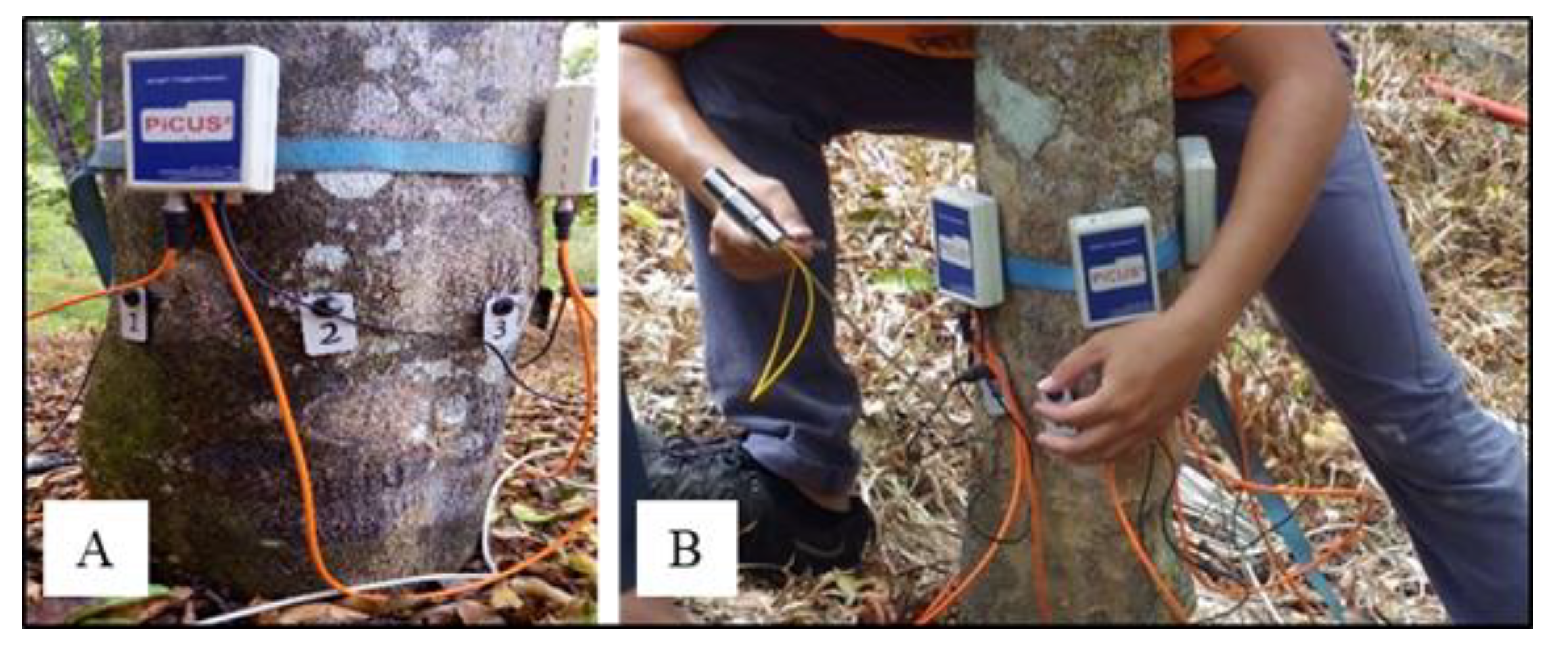
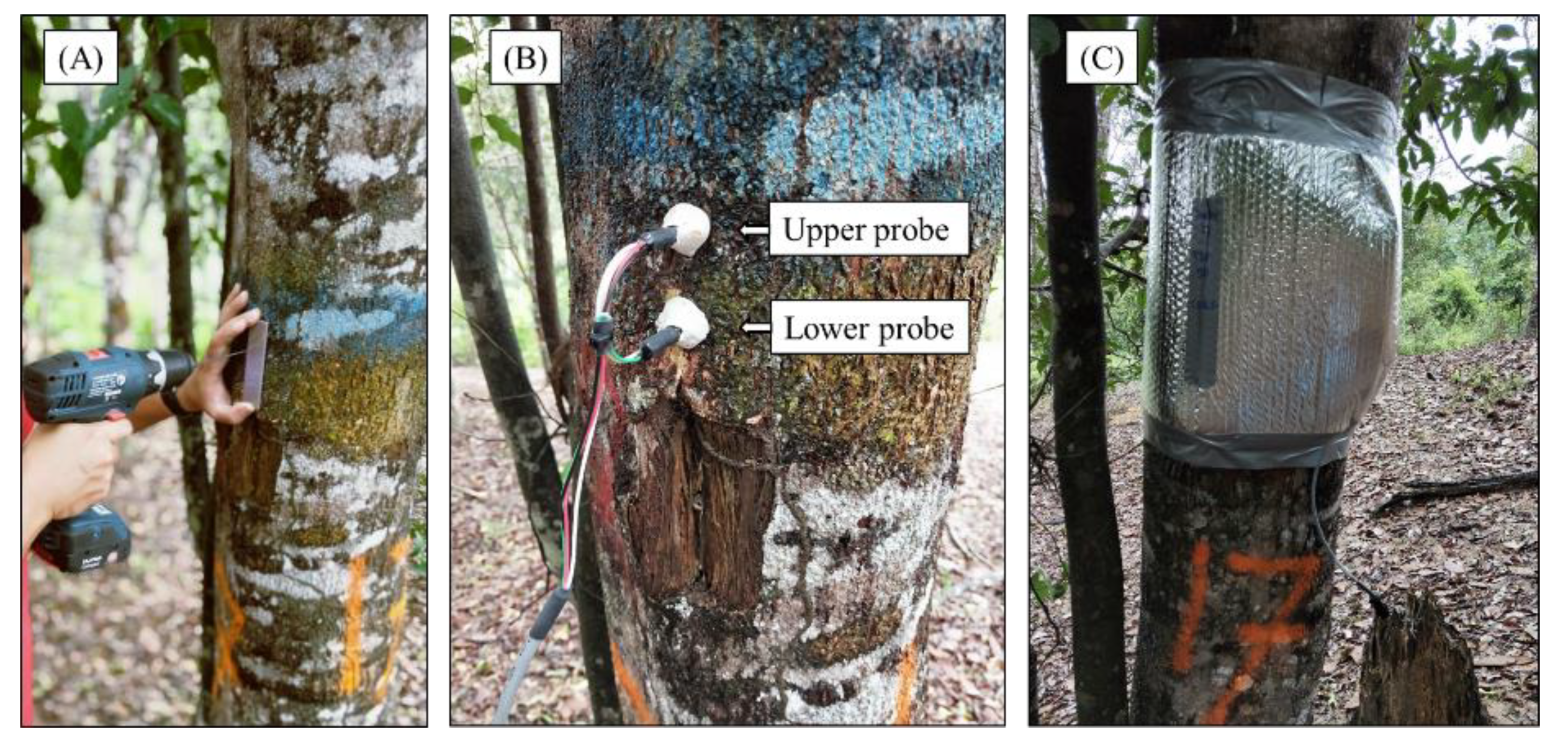

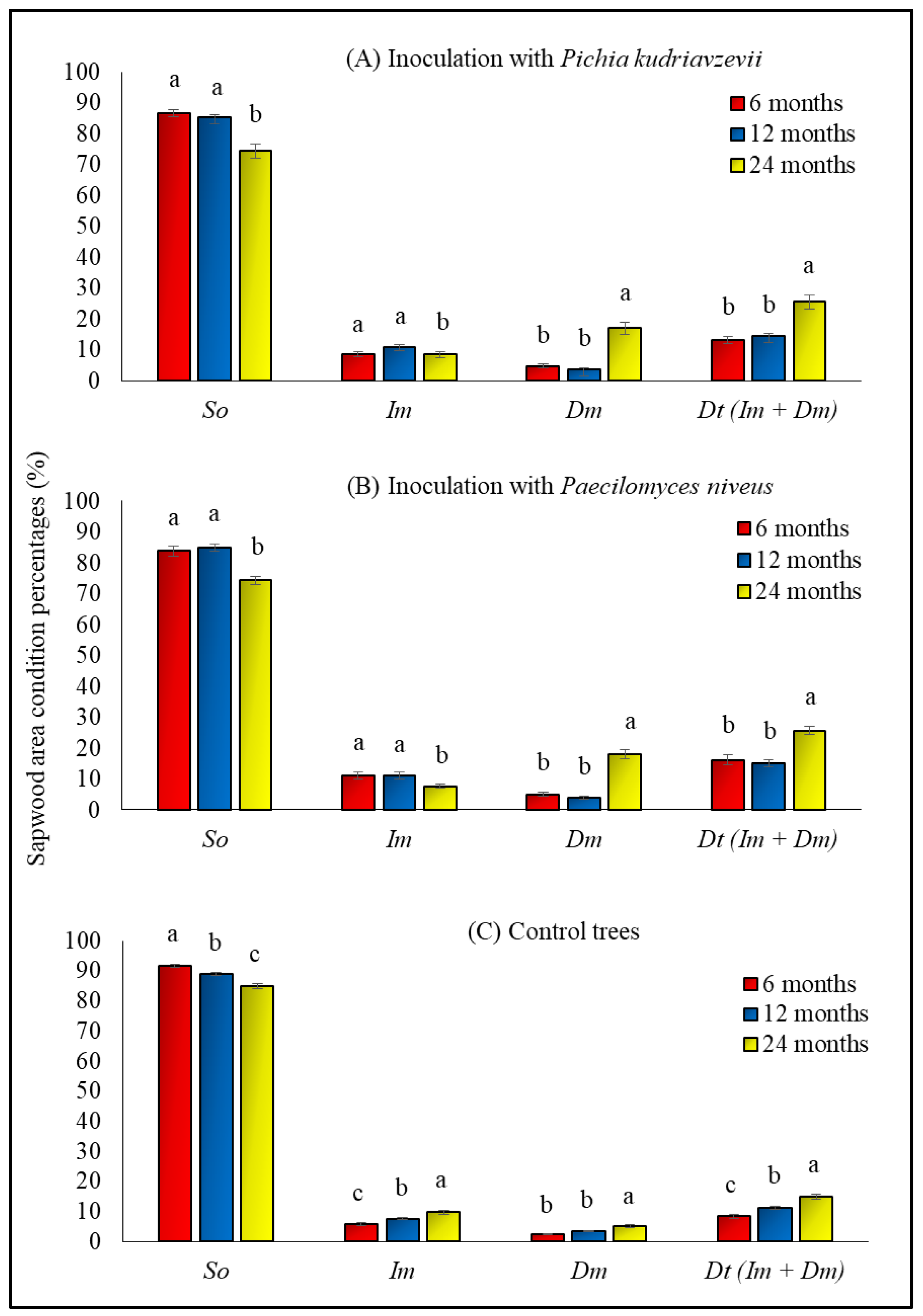
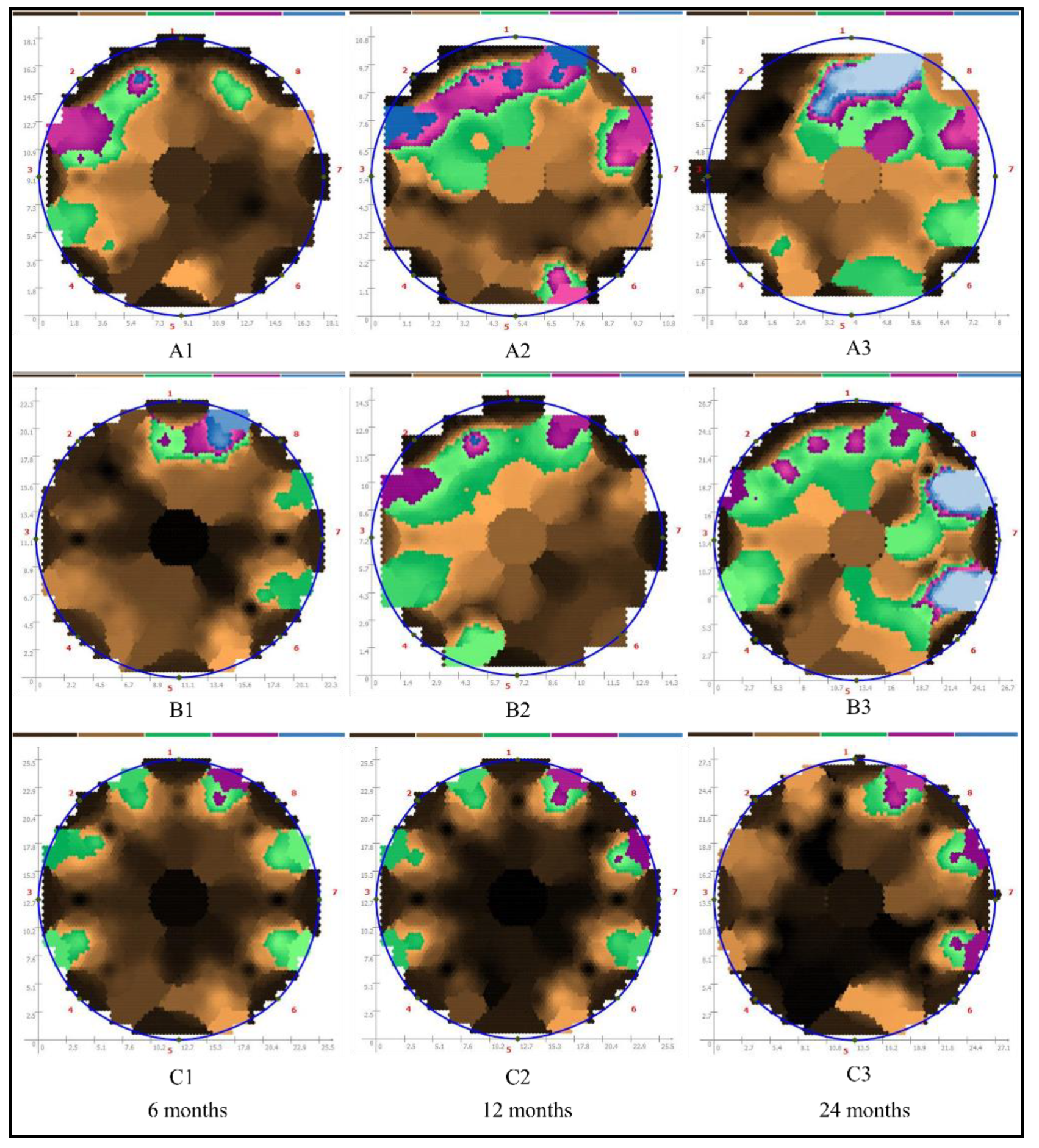
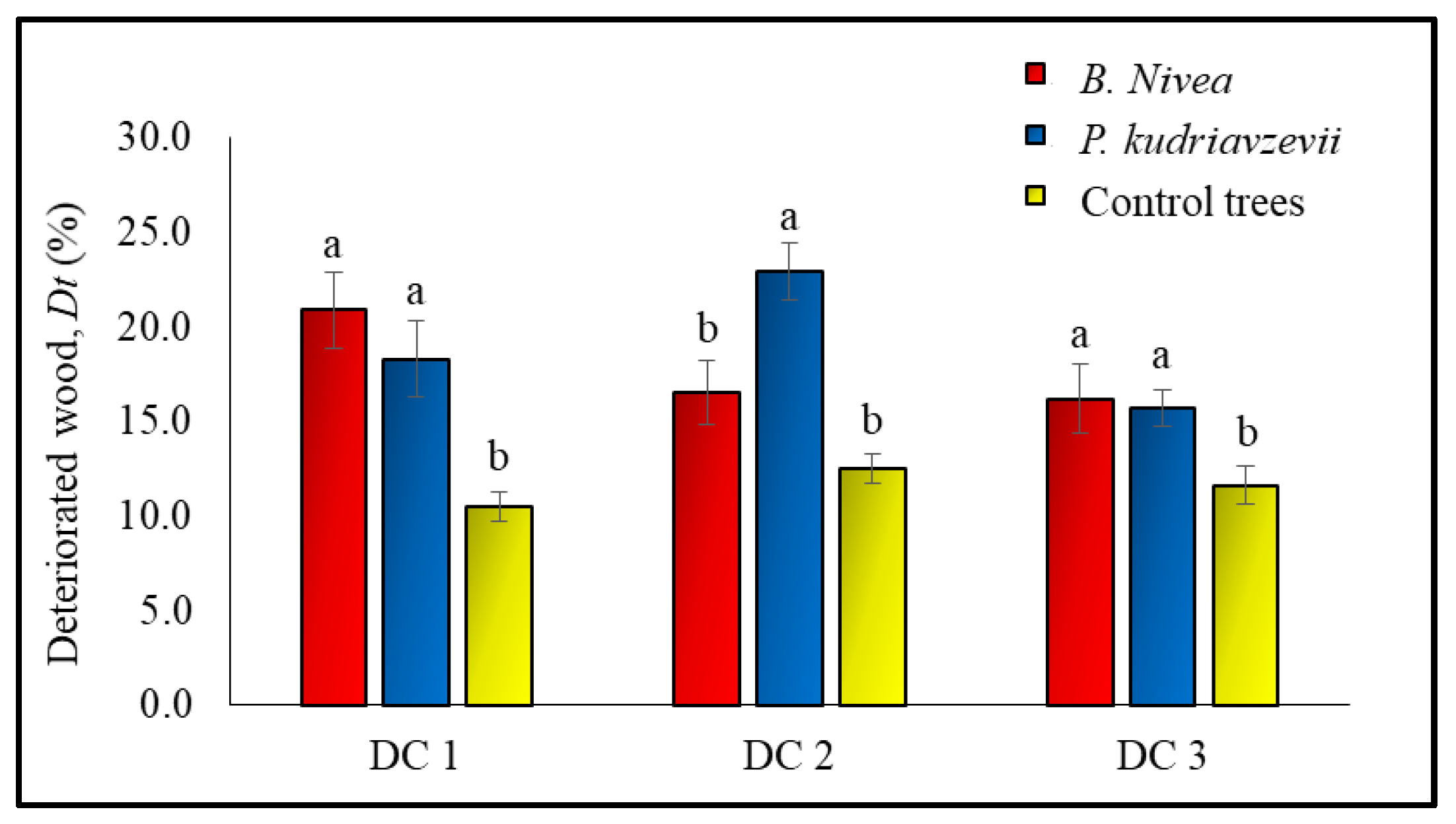
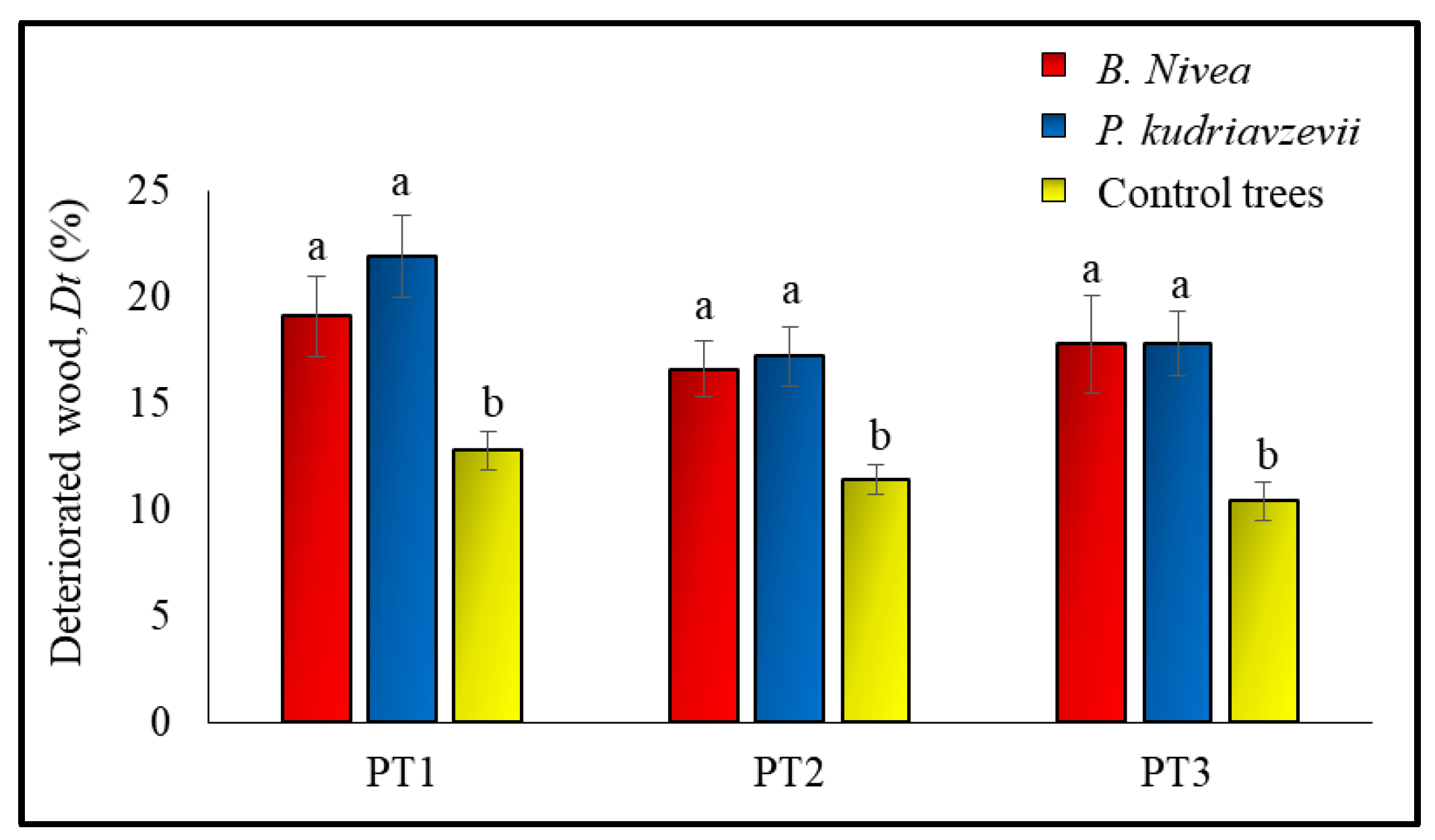


| Treatment Types | Diameter (cm) | ||
|---|---|---|---|
| Class 1 | Class 2 | Class 3 | |
| Pichia kudriavzevii Boidin, Pignal and Besson | 13.5 | 19.8 | 24.9 |
| 10.1 | 19.2 | 24.5 | |
| 7.3 | 17.0 | 28.9 | |
| Paecilomyces niveus Stolk and Samson | 10.4 | 22.7 | 25.1 |
| 12.6 | 18.0 | 26.8 | |
| 13.9 | 16.3 | 25.5 | |
| Control trees | 12.1 | 17.9 | 34.1 |
| 13.5 | 19.5 | 30.3 | |
| 14.0 | 20.7 | 29.9 | |
| Diameter | Positions | Distance from Ground (cm) | Inoculant Dosage (mL) | |||
|---|---|---|---|---|---|---|
| Pichia kudriavzevii | Paecilomyces niveus | Control Trees | Rep | |||
| Class 1 | Top | 200 | 10 | 10 | Nw | 3 |
| Middle | 130 | 10 | 10 | Nw | 3 | |
| Bottom | 30 | 10 | 10 | Nw | 3 | |
| Class 2 | Top | 200 | 10 | 10 | Nw | 3 |
| Middle | 130 | 10 | 10 | Nw | 3 | |
| Bottom | 30 | 10 | 10 | Nw | 3 | |
| Class 3 | Top | 200 | 10 | 10 | Nw | 3 |
| Middle | 130 | 10 | 10 | Nw | 3 | |
| Bottom | 30 | 10 | 10 | Nw | 3 | |
| Colour Indicator | Description | Zone | |
|---|---|---|---|
 | Brown-black | High velocity of sound waves, indicated solid intact and healthy wood | Solid wood (So) |
| Green-to-violet | Transitional condition, indicated early-to-moderate attack from the organisms | Intermediate wood (Im) | |
| Bluish | Slowed the propagation of sound waves, indicated advanced decay, or affected area | Deteriorated wood (Dt) | |
| Treatment Types | Affected Height (cm) | ||
|---|---|---|---|
| 6 Months | 12 Months | 24 Months | |
| Pichia kudriavzevii | 9.2 | 6.8 | 3.2 |
| Paecilomyces niveus | 11.8 | 10.6 | 11.5 |
| Control trees | nd | nd | nd |
| Treatments | Sap Flow Rate (cm3/h) | ||
|---|---|---|---|
| DC1 | DC2 | DC3 | |
| Pichia kudriavzevii | 207.7 b ± 14.1 | 1001.3 b ± 79.6 | 3270.4 a ± 209.1 |
| Paecilomyces niveus | 216.8 b ± 16.3 | 1465.0 a ± 98.7 | 3372.7 a ± 223.7 |
| Control trees | 312.9 a ± 21.2 | 1133.3 b ± 75.7 | 2423.2 b ± 153.4 |
Publisher’s Note: MDPI stays neutral with regard to jurisdictional claims in published maps and institutional affiliations. |
© 2022 by the authors. Licensee MDPI, Basel, Switzerland. This article is an open access article distributed under the terms and conditions of the Creative Commons Attribution (CC BY) license (https://creativecommons.org/licenses/by/4.0/).
Share and Cite
Jalil, A.-M.; Abdul-Hamid, H.; Sahrim-Lias; Anwar-Uyup, M.-K.; Md-Tahir, P.; Mohd-Razali, S.; Mohd-Noor, A.-A.; Syazwan, S.A.; Shamsul-Anuar, A.-S.; Mohamad Kasim, M.R.; et al. Assessment of the Effects of Artificial Fungi Inoculations on Agarwood Formation and Sap Flow Rate of Aquilaria malaccensis Lam. Using Sonic Tomography (SoT) and Sap Flow Meter (SFM). Forests 2022, 13, 1731. https://doi.org/10.3390/f13101731
Jalil A-M, Abdul-Hamid H, Sahrim-Lias, Anwar-Uyup M-K, Md-Tahir P, Mohd-Razali S, Mohd-Noor A-A, Syazwan SA, Shamsul-Anuar A-S, Mohamad Kasim MR, et al. Assessment of the Effects of Artificial Fungi Inoculations on Agarwood Formation and Sap Flow Rate of Aquilaria malaccensis Lam. Using Sonic Tomography (SoT) and Sap Flow Meter (SFM). Forests. 2022; 13(10):1731. https://doi.org/10.3390/f13101731
Chicago/Turabian StyleJalil, Abd-Majid, Hazandy Abdul-Hamid, Sahrim-Lias, Mohd-Khairun Anwar-Uyup, Paridah Md-Tahir, Sheriza Mohd-Razali, Ahmad-Azaruddin Mohd-Noor, Samsuddin Ahmad Syazwan, Alliesya-Shamelia Shamsul-Anuar, Mohamad Roslan Mohamad Kasim, and et al. 2022. "Assessment of the Effects of Artificial Fungi Inoculations on Agarwood Formation and Sap Flow Rate of Aquilaria malaccensis Lam. Using Sonic Tomography (SoT) and Sap Flow Meter (SFM)" Forests 13, no. 10: 1731. https://doi.org/10.3390/f13101731









